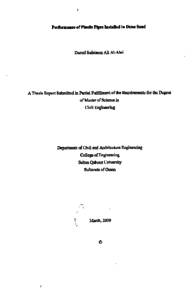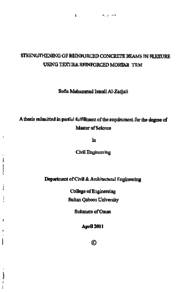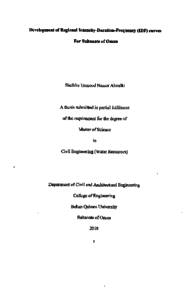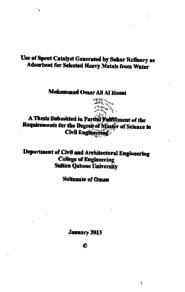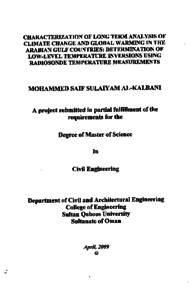Document
Performance of plastic pipes installed in dune sand
Publisher
Sultan Qaboos University
Gregorian
2009
Language
English
Subject
English abstract
Dune sands cover vast areas in Oman and suitable backfill soils for construction of buried pipes are not available in these areas. Because of the remoteness of these areas, engineers tend to use the local dune sands as backfill soils for buried pipes. However, these soils make major problems for building of infrastructures in Oman. They are generally fine-grained and poorly-graded materials with small amounts of silt. The dune sands are typified by a loose fabric structure and are vulnerable to erosion by wind and rain. They are not appropriate for support of structures and roads because they are loose and susceptible to collapse upon wetting. Dune sands are also not suitable for dam construction because of their relatively high permeability and low shear strength. In addition, the performance of buried pipes such as thermoplastic pipes installed in dune sands is not well understood. This study is intended to investigate the performance of thermoplastic pipes installed in dune sand. To achieve this objective, a plane strain finite element model was used. The finite-element program used in this study was ABAQUS/CAE, Version 6.1. The proposed model considers only one half of the system because of symmetry of the problem. The mesh extends horizontally 3-D (where D is the pipe diameter) from pipe center, 1.5-D below the invert and 2-m above the crown. Complete fixity was enforced at the lower edge of the mesh. Roller support was used at both vertical sides of the mesh. A hypoelastic constitutive model was used for soil. Full bonded or contact or slip elements were employed at pipe-soil interface. The pipe soil system response includes percentage change in vertical diameter, thrust, bending moment and shear stresses around the pipe. The study considers different factors that affect the pipe-performance such as relative density (dense, medium dense and loose dune sand soil), pipe material (i.e. HDPE, PVC), soil cover, live load and interface between soil and pipe. It has been found that the parameters used in this study have a large influential effect on the performance of thermoplastic pipes. For example, all the pipe responses (e.g. change in vertical diameter, thrust and bending moment) increase with the increase in relative density of soil and the increase in soil cover. The effect of pipe material is not as significant. There is a slight difference in percentage in vertical diameter for PVC and HDPE pipes, although the modulus of elasticity of PVC is larger than that of HDPE, However, the thrust and bending moment induced in PVC are larger than those induced in HDPE. The live load affects the percentage in vertical diameter and thrust more than the bending moment. The conditions at the interface between the pipe and the soil also affect the pipe performance. Assuming full bonded interface results in large values of change in vertical diameter and thrust than frictional or smooth interfaces. However, the opposite is true for the bending moment. The main conclusion of this study is that medium-dense to dense-dune sand can be used as a backfill material for thermoplastic plastic pipes. The predicted changes in vertical diameter using these backfills are much less than the typical specified value of 5%.
Member of
Resource URL
Arabic abstract
تغطي الكثبان الرملية مناطق واسعة في عمان والتربة المناسبة لإعادة ردم بناء الأنابيب المدفونة ليست متوفرة بها بسب بعد هذه المناطق. يميل المهندسون إلى إستخدام الكثبان الرملية المحلية كتربة لإعادة ردم بناء الأنابيب المدفونة. تسبب تربة الكثبان الرملية مشاكل رئيسية لبناء البنى التحتية في عمان حيث إنها بشكل عام تعتبر مواد فقيرة وتدرجها الحبيبي صغير وتحتوي على كميات صغيرة من التربة السلتية. لها تركيب غير متماسك وعرضة للتأكل بالريح والمطر. كما إنها ليست ملائمة لدعم التراكيب والطرق لأن حبيباتها متحركة وعرضه للإنهيار على الرطوبة. كما إنها ليست مناسبة لبناء السدود بسبب النفاذية العالية نسبيا وقوة قص منخفضة من ناحية اخرى أداء الأنابيب البلاستيكية المدفونة في الكثبان الرملية ليست مفهومة بشكل جيد جدا. هذه الدراسة تنوي تحري أداء تلك الأنابيب ولإنجاز هذا الهدف إستخدمت الدراسة نموذج السطح الثنائي الإجهاد بطريقة العناصر المحددة بواسطة برنامج التحليل آباکیس النسخة (6 . 1). النموذج المقترح أعتبر فقط نصف من النظام بسبب تناظر المسألة وكانت الشبكة أفقيا ثلاثة أضعاف قطر الأنبوب وعاموديا واحد ونصف تحت الأنبوب و أثنين متر فوق الأنبوب. تم فرض تثبيت كامل لقاع نموذج التمثيل وتثبيت قابل للحركة العامودية فقط لكلا جانبي نموذج التمثيل. تم تمثيل التربة بإستخدام مرونة هايبو. تم توظيف سطح كامل الإلتصاق وسطح به إحتكاك وسطح حر الحركة بين الأنبوب والتربة. نظام ردود التربية والأنبوب تضمن نسبة التغيير العامودي لقطر الأنبوب ، القوه المحورية، الإنحناء اللحظي وإجهاد القص حول الأنبوب. إعتبرت الدراسة عوامل مختلفة تؤثر على سلوك الأنبوب: الكثافة النسبية (الكثيفة، المتوسطة، الضعيفة)، مواد الأنبوب (أتش دي بي إي ، بي في سي)، غطاء التربة ، الحمولة الحية وسطح الإحتكاك بين الأنبوب والتربة. وقد أوضحت الدراسة بان العوامل المستخدمة لها تأثير كبير على سلوك الأنابيب البلاستكية. مثلا كل ردود فعل الأنبوب (كنسبة التغيير في قطر الأنبوب والقوة المحورية والإنحناء اللحظي ) تزيد مع زيادة الكثافة النسبية للتربية وتزيد مع زيادة غطاء التربة. تأثير نوع مواد الأنبوب ليست مهمة حيث تلاحظ بوجود اختلاف طفيف في نسبة تغيير قطر الأنبوب الأنابيب بي في سي وأتش دي بي إي وذلك على الرغم من ان معامل المرونة لأنبوب بي في سي أكبر من أنبوب أتش دي بي إي. من ناحية أخرى القوة المحورية والإنحناء اللحظي المتكون في إنبوب بي في سي أكبر من تلك المتكونة في أنبوب أتش دي بي إي. الحمولة الحية تؤثر على نسبة التغيير في قطر الأنبوب والقوة المحورية أكثر من الإنحناء اللحظي. النتيجة عند التداخل بين الأنبوب و التربة إيضا يؤثر على سلوك الانبوب. أفتراض سطح مثبت الحركة بالكامل ينتج عنه قيم كبيرة التغيير في قطر الأنبوب ومن ناحية أخرى العكس صحيح للإنحناء اللحظي الخاتمة الرئيسية لهذه الدراسة هي الكثبان الرملية الكثيفة والمتوسطة الكثافة يمكن إستخدامها كتربة لإعادة ردم بناء الأنابيب البلاستيكية حيث تلاحظ بإن نسبة التغيير في قطر الأنبوب كانت صغيرة مقارنة مع النسبة المسموح بها (5%) في مواصفات أشتو.
Category
Theses and Dissertations

